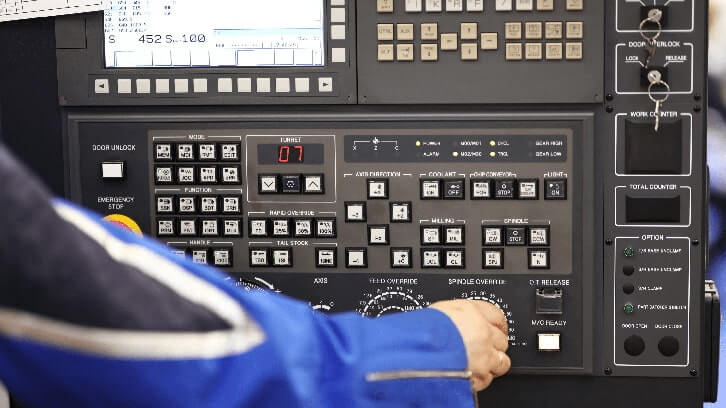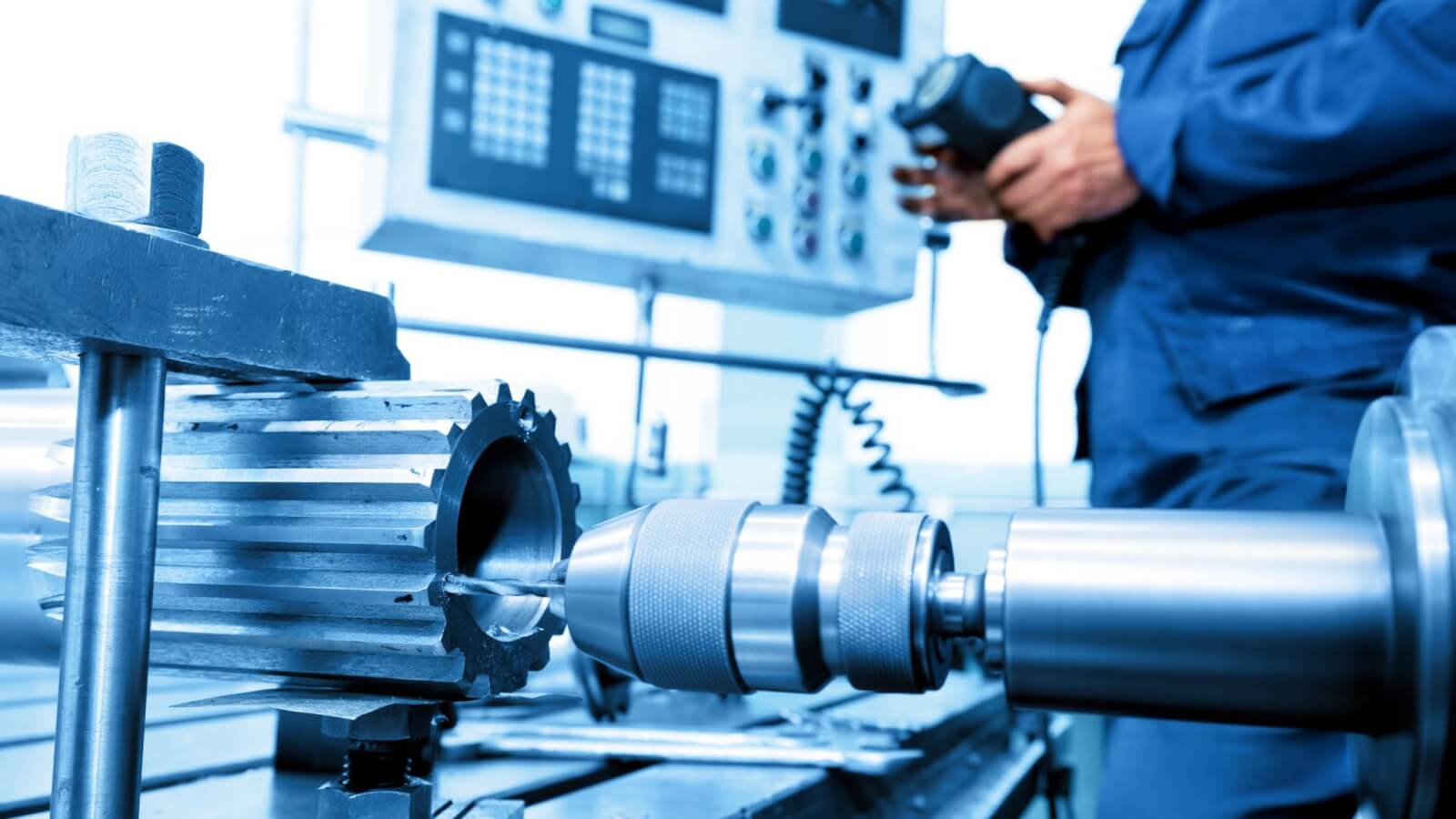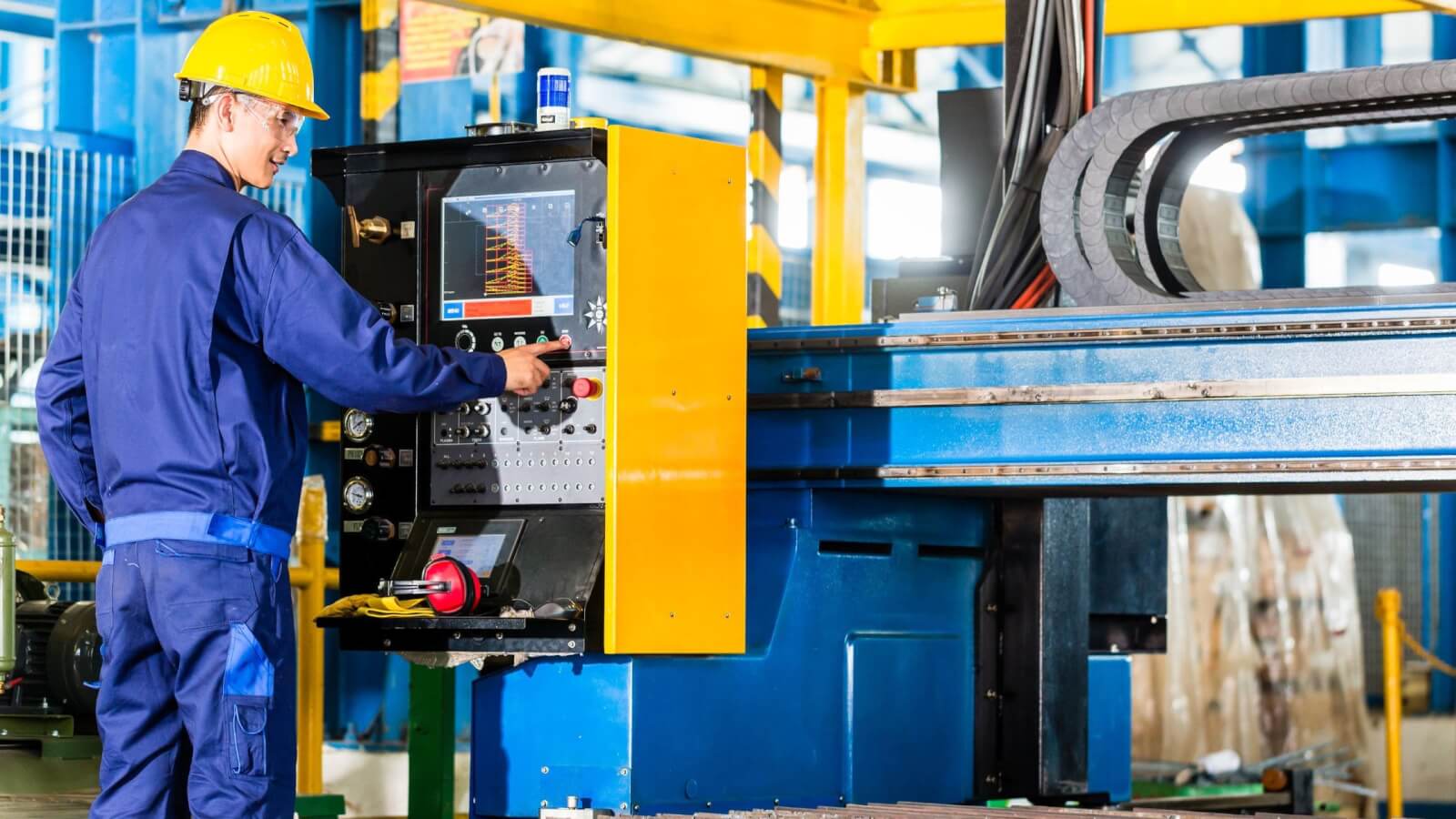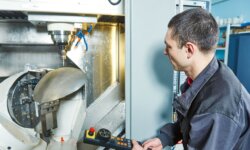Milling machines have been around for well over 300 years. They are one of the most applied industrial machining tools due to the quality and speed they bring to the table. Understanding the basics of ‘what is a milling machine?’ can give manufacturers a great alternative to stay ahead of the competition.
This article will provide an in-depth guide into the working process of a milling machine. You will learn about the many different types of milling machines, tools, benefits, and a lot of other information that will improve the outcome of any operation. Without waiting any further, let us get into the heart of the matter rightaway:
What is a Milling Machine?
A milling machine is an industrial machine tool that creates a part by removing material from a stationary workpiece with rotary cutting tools.
A milling machine is the main type of equipment used for milling, a subtractive manufacturing process, that can be controlled manually or with Computer Numerical Control (CNC). Milling machines can perform various functions by changing the shape and type of cutting tools. Due to this versatility, a milling machine is one of the most beneficial pieces of equipment in a workshop.
History of Milling Machines
Eli Whitney invented the milling machine in 1818 in New Haven, Connecticut. Before the invention of the milling machine, workers used hand files to create parts manually. This process was highly time-consuming and completely dependent on the worker’s skill.
The development of a milling machine provided dedicated machinery that could create the part in less time and without requiring the manual skill of the workforce. Early milling machines were used for government contracts such as manufacturing rifle parts.
What is the Use of Milling Machine?
A milling machine can be used for many different purposes such as machining flat surfaces, irregular surfaces, drilling, boring, threading, and slotting. Complex parts such as gears can be crafted easily with a milling machine. Milling machines are a multi-purpose machinery due to the wide variety of parts made using these.
What are the Main Components of a Milling Machine?
There are many different types of milling machines which leads to several variations in machine components. Some standard components that all milling machines share are:
- Base: The base is the foundational base component of the milling machine. The entire machine is mounted on the base. It is made of rigid materials like cast iron that can support the machine’s weight. Additionally, the base also absorbs the shock generated in the milling operation.
- Column: The column is the frame on which the machine’s moving parts are based. It provides fixtures for the driving mechanism of the machine.
- Knee: The knee of the milling machine is present over the base. It supports the weight of the work table. The knee contains a guideway and screw mechanism to change its height. It is attached to the column for vertical movement and support.
- Saddle: The saddle connects the worktable to the milling machine knee. The saddle is connected to the knee with guideways. This helps in the movement of the worktable perpendicular to the column.
- Spindle: The spindle is the part that mounts the cutting tool on the machine. In multi-axis milling machines, the spindle is capable of rotary movements.
- Arbor: Arbor is a type of tool adapter (or tool holder) that supports adding a side cutter or niche milling tools. It is aligned next to the spindle.
- Worktable: The worktable is the milling machine part that holds the workpiece. The workpiece is tightly secured on the worktable with the help of clamps or fixtures. The table is usually capable of longitudinal movements. Multi-axis milling machines contain rotary tables.
- Headstock: Headstock is the part that holds the spindle and connects it to the rest of the machine. The movement of the spindle is made possible with the motors in the headstock.
- Overarm: The overarm bears the weight of the spindle and arbor assembly. It is present on top of the column. It is also known as overhanging arm.
How Does Mill Machining Work?
1. Part Design
The process starts with the designing of the part to have a clear understanding of what is required. For CNC mills, the design process includes programming and making machine instruction files with CAM software. For manual milling machines, the part design can be a basic blueprint that includes the various dimensions.
2. Machine Setup
The milling machine requires a proper setup before the machining starts. This includes adjusting the various settings. For CNC milling machines, the program is transferred to the control system. For manual milling machines, the various parameters of the machine are adjusted as per requirement.
3. Workpiece Fixture
The workpiece is mounted on the table securely. It is important to ensure that all the fixtures and clamps are tight. Any loose fixtures result in vibrations that can cause poor-quality milling operation or even damage to the parts.
4. Milling
The milling process begins after the workpiece is fixed and the machine setup is complete. The rotary cutters remove material from the surface a little at a time. The path and shape of material removal depends on the type of the milling tool and the required shape. The rate of cutting tool movement into the workpiece is called the feed rate.
5. Part Inspection
Once the milling cycle completes, the part is removed and inspected for quality. If the quality is up to the required standard, the part is removed and sent for further processing. If it needs further work, the part undergoes another milling pass.
What are the Technical Parameters of a Milling Machine?
Having a good hold on how to use milling machines requires learning about the various parameters associated with these machines. These parameters are:
- Rotational Speed: The rotational speed is the speed at which the cutting tool rotates. It is denoted by n and measured in rotations per minute (rpm).
- Tool Diameter: The tool diameter is denoted by Dc and measured in millimeters (mm). A bigger diameter leads to a higher material removal rate. However, high-precision machining generally uses small cutters.
- Cutting Speed: The cutting speed is the linear speed of the cutting tool. It is denoted by Vc and measured in metre per minute (m/min). It is calculated by using the formula:
Vc = π x Dc x n ÷ 1000
- Feed Speed: Feed speed is the rate of movement of the cutting tool into the workpiece. It is denoted by Vf. It is calculated by the formula:
Vf = Ff x n; where Ff is the feed per revolution.
- Depth of Cut: The depth of cut is the penetration of the tool in the z-axis. A bigger depth leads to higher tool wear. The depth of cut is denoted by ap.
What are the Different Types of Milling Machines?
There are many different ways to classify milling machines and many types of machines in each classification. These various milling machines are:
Based on Spindle Orientation
Spindle orientation refers to the direction of the spindle axis. There are three classifications in this regard:
Vertical Milling Machines
A vertical milling machine has the spindle axis in the vertical plane. The cutting tool can penetrate deep into the workpiece for additional functions such as drilling and cutting. Vertical milling machines are present in two configurations: the bed mill and the turret mill. Generally, these machines have long and thin cutting tools.
Horizontal Milling Machines
A horizontal milling machine has a spindle axis in the horizontal plane. Therefore, the cutting tool approaches the workpiece from the side instead of the top. These machines generally come with a rotary table to provide an angled approach for the cutting tools. The cutting tool in horizontal milling machines is shorter and thicker.
Universal Milling Machines
A universal milling machine is capable of both horizontal and vertical milling machines. This is made possible by a worktable that can rotate to an almost perpendicular direction, providing access to complimentary planes.
Which is better: vertical or horizontal milling machines?
A vertical milling machine is considered better than a horizontal mill due to its higher versatility and more straightforward setup. This is why most milling machines are available in the vertical configuration. The maintenance requirement of vertical milling machines is lower than the horizontal counterpart.
Based on the Number of Axes
The axes of a milling machine represent the degree of freedom of the cutting tool. Simply put, the cutting tool axis is the number of directions in which the cutting tool can move. Based on these criteria, the various milling machines are:
3-axis Milling Machine
A 3-axis milling machine is the most basic type of equipment. The cutting tool is capable of moving in the three linear X, Y, and Z axes. 3-axis milling machines find a huge popularity due to their low cost and simple operations. The maintenance requirements of these machines is also lower compared to multi-axis options.
4-axis Milling Machine
A 4-axis milling machine can move in the three linear axes as well as an additional rotary axis. The rotary axis can be any one from A, B, and C axes. The A-axis is rotary around the X-axis, B is rotary around the Y-axis, and C is rotary around the Z-axis. 4-axis milling machine can create highly complex parts due to angular movement of the cutting tool.
5-axis Milling Machine
A 5-axis milling machine uses all three linear axes and any two rotary axes. It is common to use rotary tables to simplify spindle axis complexity. 5-axis machines can create complex parts at a high speed suitable for mass production.
As a leading provider of CNC milling and machining services and parts, 3ERP has 32 sets of 5-axis milling machines in-house, allowing us to meet tight tolerances and produce complex geometries. For low-cost parts, we have 3-axis and 4-axis milling machines.
6-axis Milling Machine
A 6-axis milling machine can move in all three linear axes and three rotary axes. This provides the ability to machine the work surface from all sides simultaneously without repositioning. 6-axis milling machines can provide high precision suitable for any requirement. The production speed of this machinery is adequate for mass-production.
Based on Machine Structure
There are many different types of milling machines based on how they are structured. These different types are:
Fixed Bed Milling Machine
A fixed bed milling machine has a stationary bed attached to the frame. Parts such as the knee and saddle assembly are not adjustable in the fixed bed mill. Fixed bed milling machine is a great option for performing cutting operations. Less movable parts also provide an easier maintenance of the equipment.
Knee-Type Milling Machine
A knee mill is a vertical milling machine configuration that mounts the worktable on a movable casting called the ‘knee’. The knee can travel vertically in the Z-axis. This provides the operator with the ability to adjust the vertical position of the worktable. Knee mills increase the milling machine versatility in operations such as drilling.
Planer-Type Milling Machine
A planer mill is a simple setup that cuts flat surfaces on a workpiece perpendicular to the machine tool axis. These mills are most common in woodworking for creating finished timber. Planer mills are easy to operate and maintain due to their simple setup.
C-Frame Milling Machines
A C-frame mill has a fixed spindle and knee structure that is capable of only vertical movement (Z-axis). The X-axis and Y-axis are incorporated into the worktable. C-frame mills are used for mass production due to their high milling speed.
Travelling Column Milling Machines
A traveling column milling machine has a column that can slide horizontally. The traveling column milling machine is used when machining very long parts are required. The column movement is made possible with guide rails on the machine bed.
Gantry Milling Machine
A gantry mill has a long bed that supports a gantry frame. Multiple cutters can be mounted on this gantry frame. The mounted cutters are capable of horizontal movement along the gantry, similar to traveling column milling machines. It is used for the machining of large parts.
Based on Control Method
The various milling machines based on the type of control mechanism are:
Manual Milling Machine
A manual milling machine requires the operator to move the cutting tool around by hand. This is the cheapest option for milling machine control. However, it has the lowest precision due to the high human error involved.
Tracer-Controlled Milling Machines
A tracer controlled milling machine uses the replica of the final part to guide the milling machine tool. A probe scans the replica counters and guides the cutting tool to create a similar pattern on the workpiece. It also involves a lot of manual effort to scan the replica with the probe. Additionally, it is a time-consuming and low precision control system.
Milling machine with DRO (Digital Read Out)
A digital read out milling machine is a modified form of manual control that comes with a counter displaying the accurate tool position. This helps the operator in precise positioning of the cutting tool without any human error. While it increases the precision over manual milling machines, it still requires a high time to machine. Complex shapes are hard to machine using this method.
CNC Milling Machines (Computer Numerical Control)
A Computer Numerical Control milling machine uses programming instructions to control the cutting tool. Computer Numerical Control (CNC) programs are written in CAM software prior to the machining operations. CNC is the most precise and fastest way for cutting tool movement. Most industries extensively use CNC milling machines over any other control system.
What are the Different Milling Machine Operations
There are many different operations for a milling machine. These operations are:
Slab Milling
Slab milling is a type of operation that creates flat surfaces on a workpiece. It may be used for workpiece finishing or for reducing the thickness of the part. Slab milling generally uses a horizontal oriented cutting tool with multiple toothed edges. It is also known as plain milling.
Up and Down Milling
Up milling operation describes the cutting tool rotation in the same direction as the feed. It is also called conventional machining. The down milling operation describes the cutting tool rotation in the opposite direction of the feed. Down milling is used for finishing of the part.
Face Milling
Face milling uses a cutting tool positioned perpendicular to the workpiece to remove material from the surface. The cutting tool removes minimal material to create an accurate flat surface. It can utilize both a single point and a multipoint cutting tool. It can also be used for smoothening of parts.
End Milling
An end mill uses a cylindrical cutter with toothed edges for the surface preparation of the workpieces. The direction of the cutter is similar to a drill bit. However, while a drill bit moves in the axial direction, an end mill moves sideways to remove chips from a work surface.
Gang Milling
A gang mill is a type of milling machine in which a single arbor supports multiple cutting tools. The cutters may be synchronized to perform the same milling operation or individually adjusted to perform different operations.
Straddle Milling
Straddle milling uses two end mills mounted on two different sides of the same arbor. This provides the ability to work on two different workpiece surfaces simultaneously. A spacing collar is provided to adjust the space between the two cutters as per requirement.
Form Milling
A form milling machine inscribes a combination of curves and straight lines on a workpiece surface. It can also produce contours made entirely of curves. The curves produced by form milling cutters can be both concave and convex.
Peripheral Milling
A peripheral mill setup has the milling cutter parallel to the workpiece instead of a perpendicular placing. The milling cutter can have a single point or multipoint cutting edge on the sides. The sides remove material from the top of the work surface.
Plunge Milling
A plunge mill feeds the milling cutter in the z-axis to plunge deep into the workpieces. Once the milling cutter reaches the required depth, it is retracted back in the z-axis, positioned to another X,Y coordinate and plunged again into the workpiece.
Saw Milling
Saw milling is a niche type of mill that is used for cutting logs for making lumber. Saw milling generally uses a circular or linear toothed cutter.
Groove Milling
Groove milling is used to make slots and grooves of varying diameters in the workpiece. It applies a cylindrical cutting tool that plunges into a workpiece to a shallow depth and removes material from the tool side.
Thread Milling
Thread milling is a niche mill that cuts internal or external threads in a workpiece. Threads are cut by the rotation of a single point, dual point, or triple point cutting tool.
Cam Milling
Cam milling uses a universal dividing head in a vertical configuration to produce cams. The spindle axis and the cam mill axis are parallel to each other.
Gear Milling
Gear milling is used to cut toothed gears into a round workpiece. A form-relieved cutter removes material to create the cavity between two gear teeth. The workpiece is then rotated by one gear space. The cutter then removes the next cavity. The operation follows till the gear is completely manufactured.
Angle Milling
Angle milling is used to make angled surfaces on workpieces. It is also known as angular milling. The angle of the surface depends on the contour of the milling cutters.
Profile Milling
Profile milling is used for finishing and semi finishing of a workpiece surface. It removes a minimal amount of material from a workpiece to create exceptionally flat surfaces.
Side Milling
Side milling is used to cut a flat surface on the side of the workpieces. The cutting depth is adjustable through a vertical feed screw on the table.
What is the most widely used milling technique?
Face milling is the most widely used milling technology. It is a highly versatile piece of equipment that can create a lot of different shapes on a workpiece surface. Most surface preparation stages incorporate a face mill or a slab mill.
What Materials Can a Milling Machine Cut?
- Metals and Alloys: Includes steel, copper, aluminum, brass, tin, titanium, stainless steel, etc.
- Plastics: Includes ABS, nylon, UPVC, HDPE, etc.
- Ceramics: Includes tiles, porcelain, Alumina, glass, etc.
- Composites: Includes FRP, Carbon, etc.
- Wood: Includes softwoods, hardwoods, laminates, engineered woods, etc.
What are the Different Cutting Tools in Milling?
Milling machines can use many different types of cutting tools, such as:
- End Mills: An end mill cutter is similar to a drilling bit. However, while a drill bit works axially, an end mill cutter removes material from the tool sides.
- Face Mills: A face mill cutter is relatively flatter with single or multiple sharp cutting inserts fixed on the tool.
- Shell Mills: A shell mill uses a modular approach as the cutter is designed separately with the arbor. The two can be connected with the many options available for joining.
- Slab Mills: Slab mill is a cylindrical toothed cutter. The teeth may be linear or inclined. The material is removed from the cutting tool sides.
- T-Slot Cutters: A T-slot cutter is a very thin cylindrical tool attached to a flat-toothed disc perpendicularly, forming a T.
- Slot Drills: A slot drill is a variation of an end drill that can plunge and then cut laterally through a work surface.
- Ball Nose Cutters: A ball nose cutter is a thin cylindrical cutting tool with a rounded nose. It eliminates the sharp edges and provides rounded corners in milling.
- Fly Cutters: A fly cutter is used for the planing of surfaces with a single or multipoint cutting tool.
- Thread Mills: A threat mill is a drill-like cutting tool with single or multiple cutting edges. It can cut threads inside and outside the workpiece.
- Chamfer Mills: A chamfer mill is used to create sloped edges on the workpiece surface replacing any sharp corners.
What are the Applications of Milling Machines?
Milling machines find uses in almost every manufacturing sector. Some common industries that use these machines are:
- Automotive Industry
- Aerospace Industry
- Metalworking Industry
- Electronics Industry
- Furniture and Woodworking Industry
- Construction Industry
- Mold and Die Making Industry
- Energy Industry
- Medical and Dental Industry
- Research and Development
What are the Advantages and Limitations of Milling Machines Compared to Other Machining Operations?
Milling machines have many benefits and a few limitations compared to other machining methods. Let us study each of these one by one:
Advantages of Milling Machines
- Versatile Machine: Milling operations have a very high versatility. They can create surface finish, contoured surfaces, and even work on higher depths in the workpieces.
- Precise Tolerances: A milling operation provides one of the most accurate results in any manufacturing process. The accuracy of this technology is so excellent that it is used even in sectors such as aerospace and defense.
- Consistency: Milling provides highly consistent results. This makes it favorable technology for mass production machine.
- Automation: Milling is one of the most optimal technologies for integration with a CNC machine. The entire process can be automated for fast and precise manufacturing without labor costs.
- Flexibility: Milling cutters work well on all types of materials. Even brittle materials like ceramics and glass can undergo the milling operation.
- Quality Results: Specialized milling cutters can eliminate any sharp edges and machining defects. This creates a very high-quality output.
Limitations of Milling Machines
- Cost: Milling cutters can require a high initial investment. This can be dissuading for small scale businesses.
- Space Requirement: Milling machines are bulky and can occupy a significant portion of your workshop floor.
- Tooling: Using milling machines require a careful understanding of tooling. Additionally, tooling change can take additional time leading to longer machining duration.
- Limited Accessibility: Like Most machining processes, milling can work on all faces of the workpieces except the bottom face.
How much does a new milling machine cost?
- Type of mill
- Number of axis
- Size of machine
- Brand
- Control System
How long does a milling machine typically last?
Milling machines working daily can easily last over 10 years with proper maintenance. Good quality milling machines can even push lifespan above 15 years. However, certain machine parts counted as consumables might require periodic replacement.
Is a milling machine easy to maintain?
Yes, milling machines are easy to maintain. However, the maintenance requirement of the milling machine is specific to the particular machine you use. Follow the manufacturer’s guide to learn how to maintain your milling machine.
What are the main factors to consider when selecting a milling machine?
Selecting a milling machine should be done by evaluating the factors mentioned below:
- Control System: Start by choosing a control system for the milling machine. CNC control is the most versatile system, and manual machining is the cheapest.
- Machine Type: There are many types of milling machines suitable for different shapes and applications. Choose the right type based on the part you want to machine.
- Workpiece Size: Large parts will require a gantry or moving column milling machines.
- Machine Power: Choose a power that can handle the workload of your requirements.
- Budget: Milling machines have a wide price bracket. Decide your budget to shortlist your available options.
- Build Quality: Build quality is crucial for milling machines. A machine with build quality will not be able to absorb the shocks of the milling operation.
- Configuration: Choose between a vertical mill and a horizontal mill based on machined parts and space availability.
Where to Buy a Milling Machine?
There are many options for buying a milling machine. Common choices are:
- Online Marketplace: Online stores like Knuth and APT provide milling machines with international shipping.
- Offline Marketplace: Offline marketplace includes local stores and manufacturers.
- Used Machines: You can find used milling machines at decommissioned industries in your locality.
- Milling Services: Many brands offer milling services where you can pay for final parts without investing in the equipment. This is ideal for one-time manufacturing processes and small projects.
Is Operating a Milling Machine Hard?
No, operating a milling machine is not hard or difficult. However, it requires a technical understanding of the equipment and the tooling. Therefore, only skilled operators should work on such equipment.
What are the potential hazards and dangers of a milling machine?
Milling machine parts have extreme strengths and speeds that can cut through the hardest materials. Therefore, they are a safety risk to operator limbs and other body parts. These machines also have ultra high voltages that can pose an electrocution hazard. Follow the safety guidance of the machine with adequate precautions such as guard rails and light curtains.
Endnotes
Milling machines have tremendously changed the possibilities of the part quality that can be achieved for the mass production of consumer components. The high precision of these machines even makes them the best choice for prototyping or research. If you are looking for the perfect solution for your manufacturing requirements, milling machines can be a great fit for you.
Frequently Asked Questions (FAQs)
Here are the answers to some common queries regarding milling machines:
1. What is the difference between a milling machine and a lathe?
The difference between a milling machine and lathe is that a milling machine uses a rotary cutting tool against a stationary work piece. On the other hand, a lathe uses a rotating workpiece against a stationary cutting tool.
2. What is the difference between a milling machine and a router?
The difference between a milling machine and a router is that milling machines can cut even from the hardest materials. On the other hand, routers are used to carve intricate patterns into softer workpieces of limited thickness.
3. What is the difference between a milling machine and a drill press?
The difference between a milling machine and a drilling press is that a drill can only create small diameter holes linearly in a material. On the other hand, a mill is a versatile tool that can create any shape in a material at varying depths linearly and transversely.
4. What is the difference between a milling machine and a machining center?
The difference between a milling machine and a machining center is that a machining center comes with a tool magazine for automatic tool change. This provides a single machine with multiple abilities within a single program. On the other hand, a milling machine only works with a single tool unless it is changed manually.















